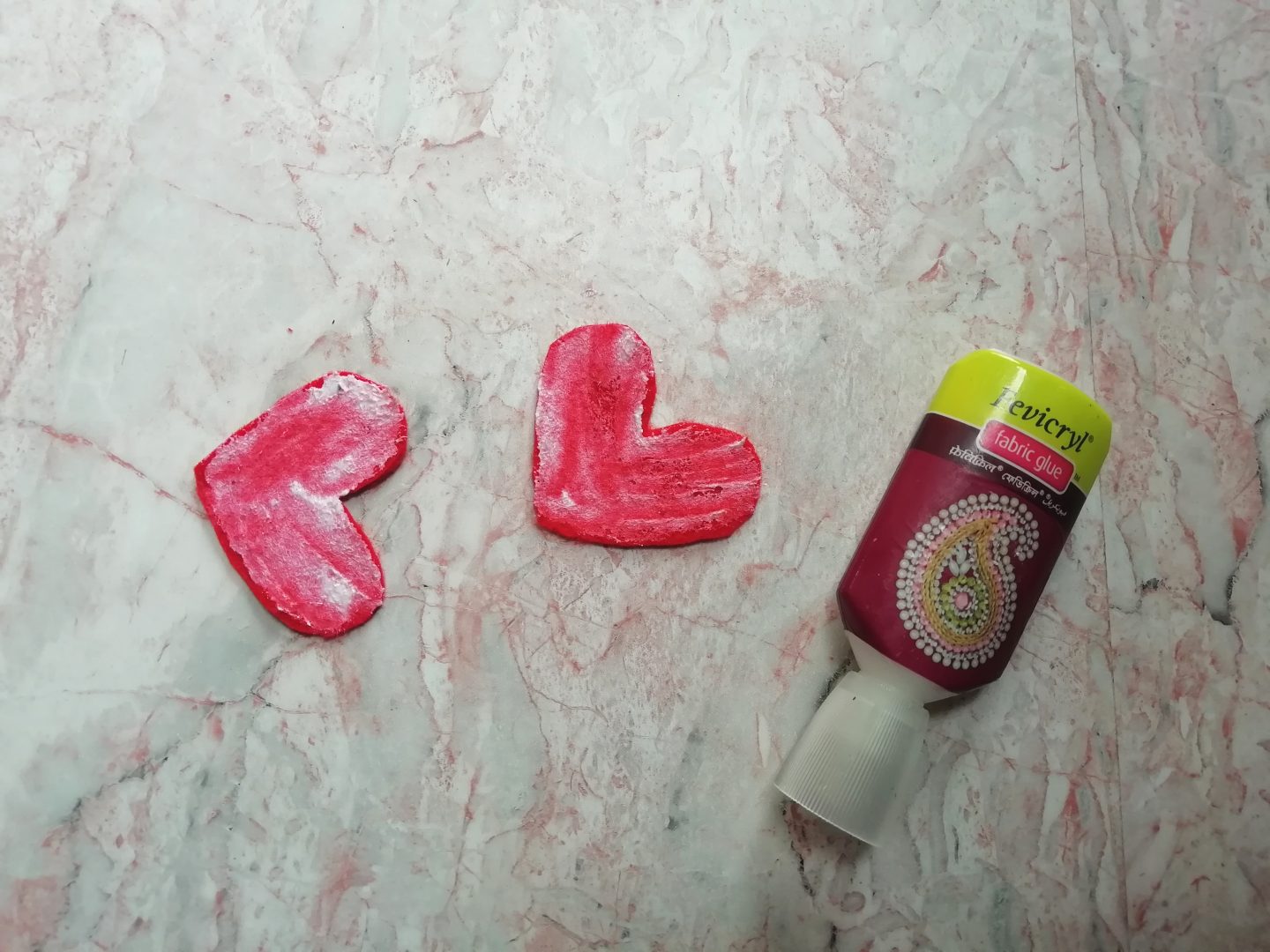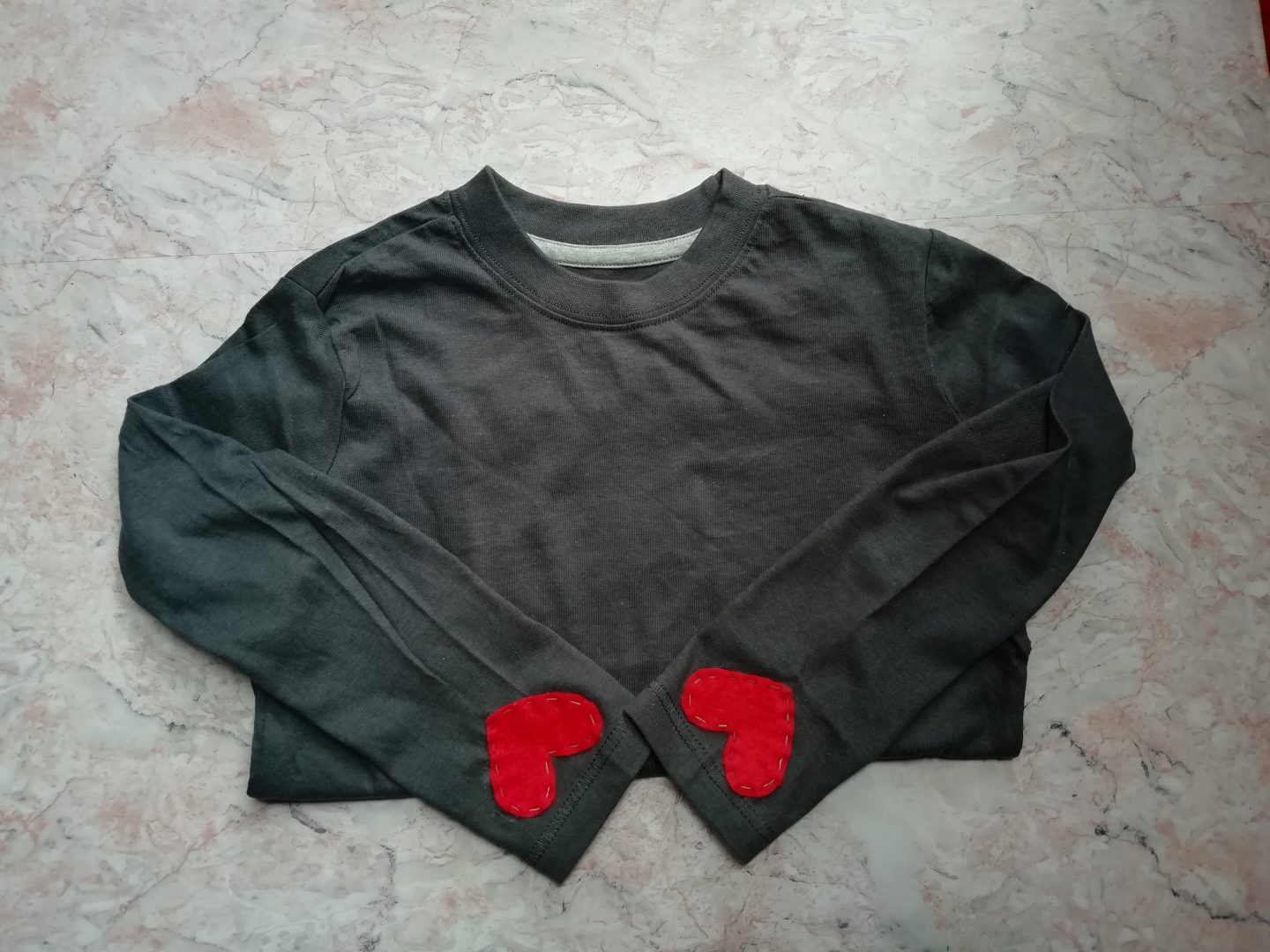Have you heard the word “upcycle” before?
Upcycle means to reuse (discarded objects or material) in such a way as to create a product of higher quality or value than the original.

It’s so easy to upcycle your clothes plus you are doing your bit for the environment and saving money!
Today’s felt patch DIY is an extremely simple way to add a personalised touch to your child’s clothes. It’s great for covering small rips or for making an outfit fit a theme.

I went for a heart felt patch on the sleeve of an inexpensive long sleeve top because my son has a thing for heart shapes, but you can just as easily cut out stars, lightening bolts or superhero symbols. (Batman symbol elbow patches seem like a super cute idea)
What you need to adhere your felt patch.

- The item of clothing you would like to “upgrade”
- Felt in the colour of your choice
- Fabric glue
- Needle and thread (I like the idea of keeping the thread the colour of the clothing item, because it gives a patchwork feel I think is rather cute)
- Scissors
- Optional: a template to trace your felt patch from (I went freehand because hearts are super simple to do)
What you do.
- Cut out the patches in the shape and size you want. If this is to cover a rip in top or pants I suggest measuring, so you are certain of coverage.
- Use fabric glue according to the brands instructions. You could get away with just sewing it on, but I find using glue gives you a more durable patch.
- Pin the patches in place and wait to dry.
- Now use a very basic stitch around the inside of the felt patch, you could use a blanket stitch which is the more common way to sew felt, but I like the look of a simple stitch like in the picture.
- There you go, an added little something to your child’s wardrobe.

Happy Crafting! ????

30 comments
Scrap copper theft prevention Copper scrap volume estimation Copper scrap resource recovery
Industrial copper waste management Copper scrap melting procedures Copper scrap energy efficiency
Copper scrap granulation Copper scrap export services Copper scrap sustainability certification
Aluminium scrap alloy separation Aluminium scrap anodizing Aluminium scrap yard operations
Scrap metal recovery plant Ferrous material regenerating Iron waste recycling depot
Ferrous metal warehousing, Iron scrap reclamation facility, Scrap metal recovery processing
Scrap metal reutilization Aluminium scrap recycling process Scrap aluminium price analysis
Scrap metal recovery and reclamation, Aluminum cable scrap inventory management, Scrap metal processing center
Scrap metal business development Ferrous material imports Iron recovery facility
Ferrous material recycling facility maintenance, Iron scrap reclaimer, Scrap metal industry standards
Scrap metal separation Ferrous material recycling returns Iron scraps recovery yard
Ferrous material refurbishing, Iron waste reclaiming services, Scrap metal collection services
Metal reprocessing yard Scrap aluminium residual waste management Aluminium scrap educational initiatives
Metal waste reclaiming solutions, Aluminum cable recycling best practices, Scrap metal transport
Scrap metal processing equipment Aluminium recycling resource recovery Scrap aluminum transportation
Scrap metal sustainability, Aluminum cable scrap market analysis, Scrap metal recovery and reclamation
Metal recovery depot Ferrous material recovery Iron scrap reclaiming
Ferrous scrap recycling efficiency, Iron waste recovery plant, Metal scrap storage
Metal scraps reprocessing Ferrous scrap sustainability Iron recovery center services
Ferrous material recycling operations, Iron scrap salvage depot, Metal reutilization yard
Metal reprocessing and recycling Aluminium scrap technology advancements Aluminium scrap processing plant
Scrap metal regenerating facility, Recycle aluminum cables, Scrap metal business development
Scrap metal processing plant Ferrous waste repurposing initiatives Iron scrap recycling services
Ferrous waste disposal yard, Recycled iron products, Metal reclaiming and repurposing
Scrap metal disassembly Aluminium scrap end-of-life management Aluminium scrap repurposing trends
Metal scrap market trends, Aluminum alloy cables, Scrap metal separation
Scrap metal salvaging Ferrous material reutilization Iron scrap regain
Ferrous material recycling industry updates, Iron alloy recycling, Scrap metal warehousing
Metal waste grading Aluminium recycling best management practices Aluminium scrap community outreach
Metal recovery and recycling, Aluminum cable for sale, Metal waste sorting center
Metal recycling depot Ferrous material safety procedures Iron scrap transport
Ferrous metal drop-off services, Scrap iron recycling center, Metal reclaiming and reprocessing
Scrap metal cutting Aluminium waste recovery methods Aluminum scrap grade classification
Scrap metal compacting, Value of aluminum cable scrap, Scrap metal repurposing
Metal evaluation services Ferrous metal buyers Iron scrap reclamation yard
Ferrous material bulk handling, Scrap iron reuse, Scrap metal inspection
Renewable copper resources International trade of Copper scrap Copper scrap management solutions
Scrap metal removal, Copper recycling technologies, Metal recycling certification
Copper scrap industry networking Copper has been used by humans for thousands of years, dating back to the ancient civilizations of Egypt, Greece, and Rome. The discovery of copper allowed early humans to develop a variety of tools, weapons, and household items that could not have been made with stone or bone alone. In ancient Egypt, copper was used to make tools and weapons, as well as decorative objects like jewelry and ornaments. The Egyptians also used copper to create elaborate plumbing systems, which were used to transport water and sewage in and out of their homes and temples. The Greeks and Romans also used copper extensively in their daily lives. The Romans, in particular, were known for their impressive engineering feats, many of which were made possible by their advanced knowledge of metallurgy. They used copper to create coins, jewelry, and metalwork for their homes and public buildings. Copper’s properties made it an ideal material for these applications. Copper is a durable metal that is resistant to corrosion, making it ideal for use in household items and outdoor structures. It is also an excellent conductor of electricity and heat, which is why it is used in electrical wiring and piping. Today, copper is still widely used in a variety of applications, from electrical wiring and plumbing to building construction and decorative arts. Its role in shaping human civilization remains one of the most enduring legacies of this remarkable metal Scrap metal reclamation methodologies Environmental impact of Copper scrap recycling Scrap Copper recycling industry Environmental copper disposal Copper scrap volume estimation Scrap metal value extraction
Copper scrap market research Mining has played a crucial role in human civilization for over 70 centuries. From the early copper mines of the Middle East to the gold rush of the Wild West, mining has shaped economies, cultures, and landscapes around the world. The ancient Egyptians were one of the earliest known mining civilizations, with evidence of copper mining dating back to the 5th millennium BCE. They used copper for tools, weapons, and jewelry, and also mined gold, silver, and other precious metals. In medieval Europe, mining was mostly done by peasants who worked in dangerous and difficult conditions. The discovery of vast silver mines in South America in the 16th century led to the rise of the Spanish empire and the influx of vast amounts of wealth into Europe. The Industrial Revolution brought about major changes in mining technology, making it possible to extract coal and iron ore on a massive scale. These resources fueled the growth of manufacturing and transportation, leading to the rise of modern cities and the global economy. Today, mining continues to be a vital industry, providing important resources for everything from construction to electronics. Although it can still be a dangerous and environmentally destructive activity, technological advances and regulatory measures have made it safer and more sustainable. As we look back on 70 centuries of mining history, we can see how mining has shaped our world in countless ways. Whether it has brought wealth and prosperity or caused hardship and strife, mining remains a fundamental part of human civilization Scrap metal value extraction Copper scrap pickup Copper scrap material analysis Copper scrap recycling machinery Copper scrap carbon footprint Scrap metal trade associations
Metal waste reclamation services Ferrous waste disposal Iron scrap recovery and processing
Ferrous material handling equipment, Iron scrap dismantling, Metal recuperation yard
Copper scrap volume forecasting Copper extrusion scrap Metal recycling and repurposing
Copper cable price, Scrap metal weighing services, Copper scrap selling
Scrap metal utilization and trading, Copper scrap buying, Copper cable scrap export cost, Metal scrap recovery and reuse
Scrap metal recycler Metal recycling and reclaiming Scrap iron repurposing
Ferrous material accident investigation, Iron reclamation and repurposing center, Metal scrap logistics
Scrap metal sourcing solutions Ferrous waste reclaiming and recovery center Iron disposal facility
Ferrous material recycling supply chain, Iron scrap recycling plant, Metal scrap recovery
Metal waste refabrication Ferrous material employee safety Iron reclaiming solutions
Ferrous material compliance, Iron and steel scrapping yard, Metal recycling salvage
Scrap metal compacting Ferrous metal reusing Iron scrap dismantling
Ferrous material environmental impact assessment, Scrap iron recovery facility, Metal reclamation facility
Metal handling services Ferrous waste reclaiming facility Iron scrap melting
Ferrous material industrial collaboration, Iron waste recycling solutions, Metal waste repackaging